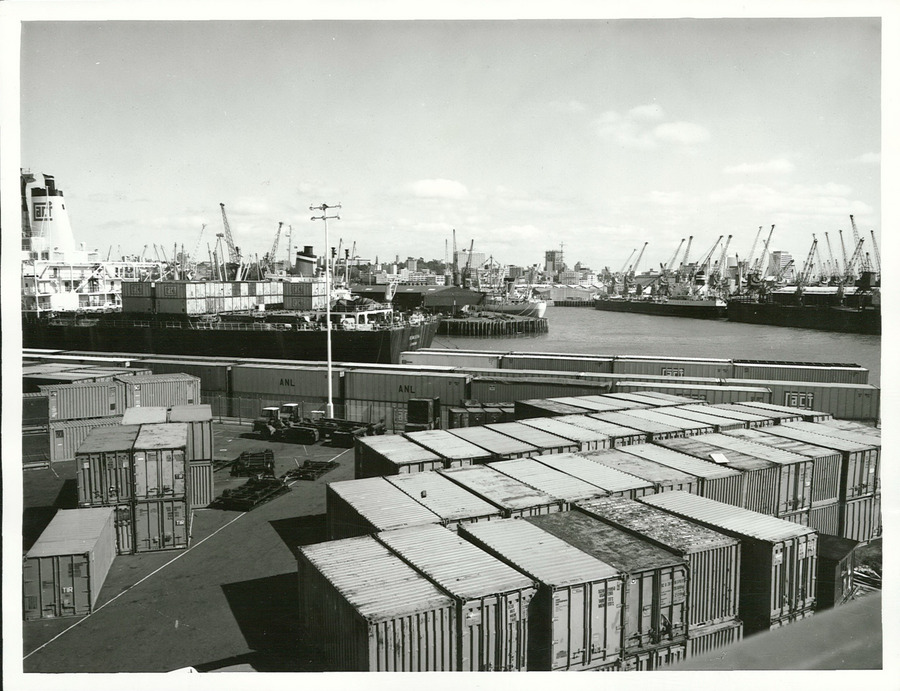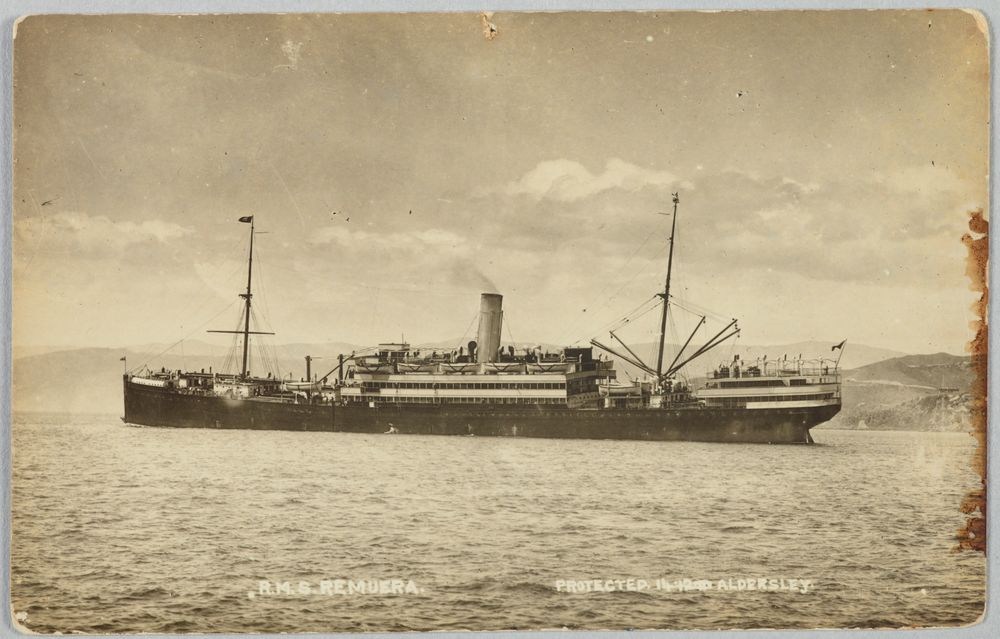RMS Remuera

All-Blacks-1924 New-Zealand-representative-rugby-union-team-boarding-the-ship-Remuera.11-030126-F.-Alexander Turnbull Library Wellington New Zealand

All-Blacks-New-Zealand-rugby-union-team-in-travelling-uniform-boarding-ship-Remuera-Crown-Studios-1924-ATL-1-1-630124-F

All Blacks-rugby team-boarding-Remuera-en-route-to UK from Kings Wharf Wellington-From-left-Brian Verden, McClear Donald, Cyril-J-Brownlie-Maurice, Joseph-Brownlie, James Joseph

Passenger list for R.M.S.Remuera leaving London on 25th August 1932 for Wellington via Curaco and Panama-Canal-ATL-fMS-papers-4293-094-12

Remuera in the Gaillard Cut in the Panama Canal 1887. Panama Canal Company 7/1/1951-10/1/1979. U.S. National Archives & Records Administration.

Remuera-Ship owned by New Zealand Shipping Company-photographed at the port of Napier between 1962 and 1964-by Harold Martin West.-14-026253-F

Brig-General G S Richardson C.B., C.M.G., N.Z.S.C. on R M S Remuera_Photographs_Albums_PH-ALB-413-p2-1. Presentation album "To Brigadier General GSR Richardson, CB,CMG, NZSC, from the London Executive of New ZealandYMCA as a token appreciation of his warm cooperation and unfailing courtesy during associated connection with NZEF, London, June 1919". Purchased from Stratford Books, 1995 ($1300)."Buckshee" - War collection ephemera.
Remuera was one of many ships that shaped the 20th century, expanding trade and taking migrants to new worlds.
In a century of two calamitous wars, she was a troop ship in the first and sunk in the second.
The New Zealand Shipping Company, her owners, was founded in New Zealand, but poor ship purchases led to financial problems and it being taken over by British interests. It retained the company name through several changes of ownership, with a fleet that was a mixture of cargo ships and combined refrigeration and passenger vessels. Remuera was one of the latter. The company had a long series of like vessels all with Maori names starting with “R”. Why Remuera? – well it was a prestigious address when the ship was launched, and this seems to have been the necessary association.
The ship was built in 1911 by W Denny and Brothers at Dumbarton on the Clyde and launched by Mrs. Arthur Rhodes, the wife of a New Zealand-based director of the company. He was a Christchurch businessman, past MP and past Mayor of Christchurch.
She measured 11,445 tons, 502 x 62 feet and had triple expansion engines and twin screws. The initial passenger accommodation was 60 first class berths, 90 second and 130 third class and the final price was £176,102 9s 4d
William Denny and Brothers were notable builders. They finished the Cutty Sark after the original builder failed. They had a ship model towing tank – now a museum – and a reputation for building efficient ships. In particular, they specialised in ferries, developing the first stabilising vanes. Ships were built there for NZSCo and Union Steamship Co. The last ship built there was Aramoana for NZ Railways Dept. Aramoana operated crossing Cook Straight from 1962 to 83.
Until the Panama Canal routing Remuera operated eastwards around the Cape of Good Hope and the Horn homewards. Early photographs on the Cape Horn route show icebergs passed at sea, no doubt a worrying sight so soon after the Titanic.
In July 1916 she was the first New Zealand Shipping Company ship to transit the Panama Canal which had opened in 1914. The delay probably relates to the large differential in charges between British and United States ships to which the British Government had objected. After that all her voyages were out and back through Panama.
At commencement, Remuera made slightly less than three return voyages a year. During the First World War the annual voyages dropped to two, constrained by the requirements of convoys and the congestion in British ports. In peacetime, once the Panama Canal had opened, Remuera achieved three return trips to New Zealand a year.
From August 1917 she was taken up as a troopship under the Liner Requisition Scheme. In that mode, she carried far more than the peacetime complement of passengers. Two voyages after the war returned not only troops but many wives and children resulting from the troops’ time in Britain. There were special welcomes in Auckland on these returns. She avoided the fate of several other ships in the fleet of being sunk by submarines or merchant cruisers. It seems she twice escaped attentions of the latter by sending spurious wireless signals, supposedly to nearby naval vessels.
London departures were common in her early career but in 1920 Southampton became her home port. Many New Zealand Shipping Company crew were NZ-based. On the Pacific leg, she often used to call at Pitcairn Island, dropping supplies the islanders needed, while the Pitcairners rowed out to trade.
A major refit converted fueling from coal to oil in 1921. She was the first oil-fired ship on a direct route to New Zealand. The refit also added an extra deck and the accommodation was changed. Initially, she retained three classes, and this seemed to suit many immigrants who trace their origins back to the ship. Still, later in her career, she was reorganized into two classes, with lesser capacity.
Remuera often travelled to different ports on the New Zealand Coast collecting cargo before making the trip to Britain. Stops included Wellington, Lyttleton, Timaru, Tokomaru Bay, Port Chalmers, Bluff, Napier, Gisborne, New Plymouth and Waikokopu. She visited Auckland 19 times between 27 June 1924 and 13 June 1940.
Two significant departures were:
- July 1924: Wellington departure Carrying the All Blacks on their second tour of the British Isles. George Nepia was the star player. The Invincibles – won all 32 matches.
- 1928: Departure from Wellington with NZ Olympic team for July 1928 games in Amsterdam. The team of eight won NZ’s first Olympic medal (as a New Zealand team) when boxer Ted Morgan won gold in the men’s welterweight.
In 1938 she came off her familiar route and went on Pacific Island cruises but was scheduled for scrapping. A prospect of war averted that and went back to the UK run.
Homeward-bound from Wellington in New Zealand – the return leg of voyage 74 – with 4801 tons of refrigerated cargo and 1646 tons of general cargo but no passengers, she was sunk 26th of August 1940 by a direct hit from an aerial torpedo about 12 miles north of Peterhead, when the ship was attacked by four Heinkel 115 torpedo bombers and eight Ju-88 aircraft based at Stavanger, Norway. All 93 crew and one gunner were saved, some by Fraserburgh lifeboat. It was the height of the Battle of Britain and her loss seemed to have raised no interest in the press, perhaps because of that, or perhaps it was censored.
She had departed Wellington on July 12th, 1940 for London. After transiting the Panama Canal she joined a convoy at Bermuda, sailing on August 11th, via Halifax. On August 25th the convoy lost ships to submarine torpedoes off the Hebrides and again early on the 26th. Remuera assumed the role of Commodore’s ship that day when the previous Commodore’s ship was lost. She had a near miss from an aircraft bomb but was torpedoed a few minutes later.
She is a dive-able wreck, but at a depth that is challenging. It is now privately owned by a group of enthusiasts who want it left intact. They are progressively mapping the wreck – which is one of the largest in NE Scotland.
Courtesy Jim Burke (from a dive, 2002): “All the accommodation is gone with the starboard side lying on top of the port side and her beam reduced to about 3 to 4 m. The wreck is lying on her port side, reasonably well intact but with her starboard side collapsed reducing her beam to around 3 m. Most of her superstructure has gone but she is still recognisable from photographs. The bow line is intact, with a massive anchor hanging towards the seabed. Heading sternwards, her hull is fairly intact but flattened, here and there, massive cracks allow an uninterrupted view of her holds. Her huge foremast lies out on the seabed.”
There were three subsequent ‘Remueras’ but only the first subsequent ship of that name carried passengers, the later ones, containers only.
The New Zealand Shipping Company fell into decline with the advent of container vessels that could carry “reefer” containers and particularly with the growth of international air travel which rendered their market position of ships with mixed passengers and freight untenable.
Garry Law
December 2019


















